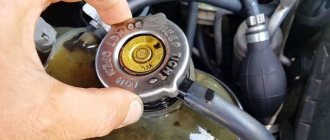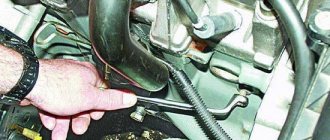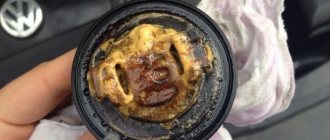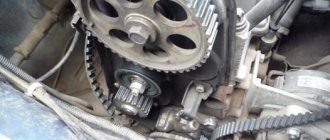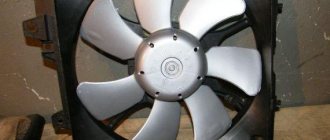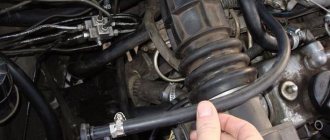Probably, many motorists have encountered the fact that the car’s cooling system became clogged and required cleaning. So, on the VAZ-2114 it periodically requires this process to be completed. But not all car enthusiasts are able to perform this action with their own hands. This article tells you how to flush your cooling system yourself.
The video below discusses the most basic methods and means for flushing the cooling system on modern cars:
The video will tell you how to clean the cooling system with your own hands and what you will need for this.
Cooling system design
In order to clean the cooling system, you need to understand what elements it consists of and where the coolant flows.
So, let's look at how the VAZ-2114 engine cooling system works:
Schematic diagram of the engine cooling system
1 – element in the form of a plug for the expansion tank; 2 – expansion tank; 3 – hose for draining liquid from the pipe; 4 – hose passing between the radiator and the expansion tank; 5 – hose leading from the radiator; 6 – tank to the left of the radiator; 7 – aluminum tube; 8 – plug systems; 9 – tank to the right of the radiator; 10 – drain plug; 11 – middle of the radiator; 12 – casing for electric fan; 13 – plastic wings of the electric fan; 14 – electric motor; 15 – toothed pump pulley; 16 – pump impeller; 17 – camshaft drive belt; 18 – engine block; 19 – pump pipe; 20 – radiator hose with supply function; 21 – heater radiator hose with drain function; 22 – hose supplying coolant to the throttle pipe; 23 – exhaust pipe; 24 – hose for refilling; 25 – heater radiator hose with supply function; 26 – thermostat; 27 – coolant temperature sensor; 28 – coolant level indicator sensor.
When flushing is necessary
Dirt that flows from the cooling system pipe
Everyone understands that the cooling system, especially in the radiator part, can become clogged. This is due to the fact that the operating temperature of the liquid is quite high and it gradually loses its chemical and physical properties.
Thus, it causes residues to settle on the walls of metal tubes, of which there are plenty in this system. But, despite such a difficult diagnosis, it is possible to cope with it.
Of all the available coolants, the heaviest to deposit is antifreeze, although all manufacturers recommend this type. Of course, distilled water is considered the softest for heavy precipitation and leaves almost none, but it has a big disadvantage - it causes corrosion . Read more about choosing a coolant in this material.
Filling liquid to flush the cooling system
It is quite simple to track contamination of the cooling system - the engine gets very hot even in severe frosts.
Another sign is that the thermostat quickly fails (see “replacing the thermostat”). This is due to the fact that the system is overheating. Sometimes, not often, a clogged system can lead to pressure in the system increasing, and the rubber pipes cannot withstand it and begin to leak and crack. In this case, we recommend installing a thermostat from Lada Granta.
In order to prevent such consequences, it is necessary to clean the cooling system from time to time. As practice shows, and also recommended by car manufacturers, cleaning of pipelines with a complete replacement of the coolant should be done every 50,000 km .
We have already written about the choice of coolant.
Consequences of a dirty cooling system
In addition to the fact that a clogged system will lead to heating of the engine, as well as the creation of pressure, excessive overheating of the power unit will lead to sagging or deformation of the cylinder head. In this case, the first fault that appears is a breakdown of the gaskets, especially under the cylinder head.
The appearance of the coolant seems to hint
Further, a major overhaul of the head may follow, during which it will be necessary to grind the plane, as well as change the main spare parts.
But this is not the whole process of engine destruction due to overheating. If coolant gets into the main power unit, or rather into the cylinders, a water hammer will occur, which will completely disable it.
Methods for cleaning the cooling system
During operation of the cooling system, two most suitable flushing methods were identified:
- External cleaning. This process removes all contaminants from the external cooling elements. This can be done using a spore of water and shampoo. But, with the development of modern technologies, it is best to do this process using a mini-wash, which supplies water liquid with the necessary detergents.
External radiator cleaning with water - Internal cleaning. This process removes all deposits, debris and scale that have accumulated in the cooling system. This process will require special tools, as well as disassembly of some elements. If this method does not work, then only replacing the radiator will help!
Cooling System Flush
We’ve sorted out the methods for flushing the cooling system, and it’s worth moving on to the question of what can be used to flush this unit.
How to flush the cooling system (basic products)
At first glance, everything seems quite complicated, but in reality it is not so. There are several ways and means to flush the cooling system. So, let's consider all the possible options for performing the operation, as well as the means by which this can be done.
Distilled water
Distilled water - as a means for flushing the cooling system
This is the cheapest and most common option for flushing the engine cooling system. But, the process has a significant disadvantage in the form of low efficiency and therefore its use is required more often. So, let's look at the process itself:
- Having unscrewed the drain plugs on the block and radiator, we wait until the old “coolant” drains.
- Pour distilled water into the system in proportion to the coolant.
- Now, you need to start the main power unit and let it run for 15-20 minutes.
- We turn off the engine and drain the water through the radiator cap. You should not drain through the hole on the block, since all the debris may remain in the block and not exit the system.
This operation must be done 3-4 times, or until the color of the outlet water stops changing and no remaining dirt comes out of the system. Each time you need to fill in new water.
Acids, soda and vinegar
Ingredients to create a wash solution
This method shows high efficiency of use, but is considered harsh and rough. In order to make the desired solution, mix citric acid (25%), soda (50%) and vinegar (25%). Drain some coolant from the system and add the solution. 1 liter of this fluid will be enough for the entire engine.
Warning! If you overdo it with acid or vinegar, then all the rubber elements that they meet along the way will become unusable and will have to be replaced.
Therefore, proportions must be strictly observed. After the solution has entered the system and spread throughout it, you must wait 6-8 hours . It is best to leave it overnight.
Antifreeze after washing
After the expiration date, drain all the liquid from the system and perform a one-time flush with distilled water.
Then rinse with distilled water
Special cleaning products
Special cooling system flushing agents
Today, progress has stepped much forward, and you can not “reinvent the wheel” in the form of old solutions that were used on Soviet cars, but buy a ready-made flushing agent. Of course, the cost is much more expensive than previous methods, but the effect will be maximum.
The finished product contains elements that dissolve scale, fats, complex deposits and other contaminants that have entered the system. In 2-3 hours the system will be completely cleaned , and the owner will be able to enjoy further use. After completing the flushing process, it is necessary to change the coolant.
Many motorists recommend FELIX flushing fluid
Ready-made products that can be found on the automotive market or in a car dealership come in three types - acidic, alkaline and neutral. 2 and 3 are very popular. In 2015, automakers decided to abandon the use of acidic flushing agents, since they destroy some elements of the main power unit.
Replacement
Now we can talk directly about how the coolant is drained and new antifreeze is added.
We noted that 7.8 liters of antifreeze are required to fill the entire volume of the coolant tank. But it is best to purchase a 10 liter canister. This is useful in case you spill some of the liquid past the neck, and also if you need to top up the coolant over time.
If you carry out the work in a clear sequence, watch preliminary training video instructions, then replacing antifreeze or antifreeze will become an easy task for you.
- Remove the main motor protection. To do this, there are four fasteners under the engine compartment. Although not all cars have protection.
- Remove the protective cover. It is located in front of the body under the engine.
- Unscrew the cap from the expansion tank.
- We climb into the cabin and open the heater tap all the way. This will prevent some of the coolant from remaining inside the system when drained.
- Prepare a container where all coolant from the system will be drained. A basin or other wide dish is better suited so that nothing spills past.
- There is a drain plug on the radiator. You will find it on the lower left, in close proximity to the radiator.
- Don't rush to drain the coolant. First, be sure to protect the generator from antifreeze. To do this, you can wrap it in plastic and put on a bag.
- Now drain all contents from the radiator.
Article on the topic: Repair and replacement of rear lights on a VAZ 2114
- Give yourself access to the drain plug on the cylinder block. To do this, you will have to remove the three bolts securing the ignition module.
- Place the module aside. Underneath it you will find a plug.
- Unscrew the plug and drain the old coolant solution.
- Let the car sit for about 15 minutes. This time should be enough for all the coolant to leave the system. Just remember, the engine must be cold.
- At this stage, you can flush the system if desired and necessary.
- After draining and flushing the system, tighten all plugs.
- Arm yourself with a canister and go to the expansion tank, which is located in the engine compartment. Remove the lid and begin to gradually pour in antifreeze or antifreeze.
- To avoid spilling the mixture, use a funnel. By inserting it into the fill hole, the coolant update procedure will be much easier.
- Be guided by the amount of coolant remaining in the canister. In some situations, an air lock may form in the system.
- To get rid of the plug, compress and release the upper hoses on the radiator.
- When filling is complete, you should have no more than 2 liters of liquid left in the canister.
Removing the airlock
How difficult is it to clean?
This procedure is not difficult at all, so the driver does not have to worry about not being able to do it. Any malfunction that concerns contamination of the cooling system channels can be corrected by flushing.
How often should this procedure be performed? Flushing the VAZ 2114 engine cooling system should be done as often as possible, although even if the car owner does this only once a year, he can still achieve a positive result. By flushing, you can prevent the occurrence of various problems associated with the cooling unit of the machine.
Consequences of untimely flushing
Additional Information. Most often, the need for flushing arises due to insufficiently competent use of antifreeze. Many car enthusiasts do not even pay attention to the fact that the antifreeze used has expired. When this happens, the antifreeze can cause serious damage to the car. In this case, sooner or later problems will arise in the cooling system. As a result, the motor may unexpectedly overheat.
When to change?
We have already determined that, from the point of view of the needs of the VAZ 2114, antifreeze is best suited for this car. Although the plant itself has clear recommendations and standards in this regard. If you have a really high-quality antifreeze, which costs more than antifreeze, its performance efficiency will not be inferior to VAZ’s development, and in some places it may even be better.
But first, let’s determine exactly when the coolant needs to be replaced. It all depends on each specific situation, so there are several recommendations in this regard.
- When buying a new car, it should be replaced after every 60 thousand kilometers traveled.
- The standard service life of filled coolant is 2 years. Under normal operating conditions, it is sufficient to change it every two years.
- The coolant must be replaced immediately if its color has acquired a cloudy structure or a rusty tint.
- If the coolant leaked and water was used as a top-up, you need to eliminate the source of the leak and replace all the antifreeze.
- If the engine has been repaired or dismantled, the coolant must be replaced, regardless of its current condition.
Article on the topic: Replacing the release bearing on a VAZ 2114, the principle of checking it
What to fill?
A question that interests many is the volume of liquid that should be poured into the engine cooling system of the VAZ 2114. We answer. The volume of antifreeze or antifreeze is exactly 7.8 liters.
Since we agreed that antifreeze would be the best choice, let’s talk about its varieties and determine which one is best to use.
| Type of antifreeze | Peculiarities |
| AK | This antifreeze is a concentrate, so it cannot be poured in its pure form. Diluted with water in proportions of 1 to 1. The freezing point after dilution will be -30 degrees Celsius |
| A65 | Already diluted antifreeze that does not require adding water. The freezing point of the liquid is -65 degrees Celsius |
| A40 | The most common version of antifreeze for the VAZ 2114. Its freezing point is -40 degrees Celsius |
Decide for yourself which of this you will pour into the engine cooling system. Each of the three presented types of coolant has its own characteristics and works equally effectively for the benefit of your car.
Do not forget about the existence of high-quality antifreezes. They cost more, but last about 1-2 years longer.
What is the best way to flush the cooling system at a service station or do it yourself?
The first option is certainly simpler, but it is also more expensive, the second is less pleasant, but you will gain invaluable experience and also get good savings. If you are not short on time and have a little understanding of what SOD is, then I recommend flushing the cooling system yourself. Read on to find out how to do this.
Features and methods of flushing the cooling system
As I already said, unfortunately, the vast majority of car owners do not even know about the need to carry out such a procedure, perhaps you do the same - just add antifreeze to the level and that’s it. However, this will not always be the case, and at one unpleasant moment the cooling system will simply stop functioning, and you will get overheating with all the consequences... I recommend monitoring the condition of the antifreeze, and not adding it, but making a complete replacement, then during draining you will be able to see in what condition he is in. If you have drained the coolant and it is black or dark brown, you know that your cooling system has big problems.
Citric acid into the expansion tank "techika" - radiator for release
Any technical fluid needs to be changed periodically. Antifreeze in the cooling system is no exception. How long it will last is determined mainly by the durability of the additives that inhibit the chemical activity of antifreeze in relation to the materials from which the cooling system components are made. Sergei Volkov dealt with a very unusual case.
The most common antifreezes are silicate and carboxylate. They received their names because of the anti-corrosion additives that are used in this or that coolant. In our conditions, it is recommended to change silicate antifreezes after three years of operation, carboxylate ones after five or six.
The problem is that not all car owners adhere to the recommended cooling system maintenance intervals. The older and more used the car, the more likely it is that the antifreeze has not been changed for a long time.
But now the car has a new owner. He eliminates malfunctions that exist in any used car, changes engine oil and filters, looks at what is in the power steering reservoir, brake master cylinder, and expansion tank of the cooling system.
Every more or less experienced driver knows what antifreeze should look like. If he sees a cloudy reddish-brown liquid in the expansion tank, this cannot but alert him.
When is it necessary to flush the engine cooling system?
Contamination of the technical channels of the internal combustion engine is indicated by the constant operation of the fan on the cooling radiator and malfunctions of the heating system. The problem must be resolved as soon as possible. You can do this yourself.
A number of signs indicate the need to flush the engine cooling system:
- regular overheating and problems with subsequent startup of the power unit;
- slow response to the rheostat signal;
- high readings of the coolant temperature sensor after starting the engine;
- pump operation with constant interruptions;
- change in the color of the coolant in the tank.
If such symptoms occur, it is necessary to immediately change the fluid for flushing the engine cooling system.
Additionally, we recommend reading the article by our specialist, which describes in detail the cooling system of the VAZ-2110.
We also recommend that you carefully study our expert’s article on the description of the cooling system of the VAZ-2107.
The system can be cleaned using household products or special chemical additives.
Causes of insufficient engine cooling
- The appearance of extensive plaque on the inner surface of the walls of the lines and radiator pipes. Plaque on the tubes appears during the oxidation of the coolant under the influence of a constant temperature difference in the engine. Since the deposits that appear in the hoses have low thermal conductivity, the engine does not cool. Heat exchange between the engine and the tubes with liquid is greatly limited, and heat simply does not pass through the resulting layer of scale.
- Contamination of the internal radiator pipes with dust and small metal particles. When dust appears in the cooling system, heat exchange with the engine is completely disrupted. In turn, small metal particles will contribute to rapid overheating of the engine.
- The appearance of an air lock inside the system. When an air lock forms in the tubes, the coolant cannot fully circulate through all the lines.
Tip: if you notice that the engine suddenly stalls at full speed, the problem probably lies in the engine cooling system.
As a result, if you do not flush the cooling system yourself or at a car service center, in a couple of years you will have to completely replace the engine.
Solving the problem with a faulty heater. Flushing the heater radiator
Cleaning the radiator of the VAZ-2114 stove is necessary only if the unit is clogged. This problem can manifest itself as a lack of heat, which should enter the cabin when the heating is turned on. Therefore, if the heater with activated positive heating does not function properly, you should check the level of antifreeze poured into the cooling system before removing the radiator. Antifreeze must be present in sufficient quantities in the system, and such a phenomenon as an air lock should not be observed.
The most “ancient” way to solve the problem
If a motorist has doubts about how to clean the stove on a VAZ-2114, he should start by draining the antifreeze that fills the cooling system of the power unit.
You should first stock up on several packages of citric acid, and you should have at least 100 grams available. of this substance. Then the existing acid should be poured into clean water. Experts recommend boiling the water first and letting it sit. It is important to calculate the volume of liquid required, which should be equal to the amount of antifreeze. As a result, the existing solution should be poured into the cooling system.
After this, you should drive your car as usual for a week, without mixing citric acid with water. After a week, you should remove the water, which will most likely have a black color due to dirt.
The only thing that should be taken into account is that flushing the radiator of the VAZ-2114 stove should be carried out in the warm season or in the garage, since under no circumstances should the car be allowed to remain in the cold for a long time. Otherwise, the water in the system will freeze and the consequences may be more than tragic.
Flushing the VAZ 2114 cooling system
Salute dear motorists! The topic of our dialogue today will help many beginners, and even experienced drivers, to protect the engine from unwanted overheating. Flushing the VAZ 2114 cooling system is the most important procedure for cleaning all lines from foreign elements. Despite this, only a few of us carry out such an event regularly, and even one flush per year will prevent many problems from occurring with the cooling unit. Any person more or less knowledgeable about such matters will say that in fact the process is absolutely simple. The main thing is that the cause really is due to contamination of the channels. If you are faced with such a nuisance as a clogged cooling system and have no idea how to flush it, and most importantly, with what, then I have found my interlocutor. In this case, I propose to learn all the intricacies of the procedure, which can both “cure” your car and act as a tool for its prevention.
Replacing coolant VAZ 2114
Regular replacement of coolant on any car is a procedure that every owner of his own vehicle must perform. It doesn’t matter whether it is a domestic manufacturer or a foreign one, the coolant can lead to several unpleasant factors if its replacement is ignored.
Diesel, carburetor, and even gasoline engines - they all need timely flushing of the system. Replacing the coolant on a VAZ 2114 must be followed in strict order, fulfilling all the conditions in order to properly care for your car.
Engine oil and its purpose
The purpose of the lubricating fluid in the power unit is clear - reducing friction, timely removal of heat and ensuring reliable operation of all mechanisms.
Ideally, oil can last indefinitely. But! The car engine operates under constant overload conditions - high pressure, sudden temperature changes and mechanical stress.
Under such conditions, the oil begins to lose its properties and oxidize. Such “waste” ends up in a variety of places - deposited in engine gaps, oil grooves and other engine elements.
Each time the quality of the lubrication of the power unit becomes worse. This, in turn, affects the characteristics of its work. It turns out to be a chain reaction.
As a result of oil oxidation, a whole “bouquet” of foreign elements appears - resinous and carbon deposits, as well as acids. The action of the latter (acids) accelerates the process of corrosion formation and changes the characteristics of the oil.
Over time, the following appears on the internal elements of the engine:
- Sludge - inevitably leads to a deterioration in the characteristics of the oil and an increase in its viscosity characteristics;
- varnish - appears on the inside of the piston, connecting rods and fingers. Such “spraying” leads to deterioration of heat dissipation, a decrease in the strength of engine elements, and deterioration of their lubrication;
- carbon deposits cause the destruction of fuel and lubricant and have a dark color. Its occurrence can lead to frequent problems with engine cooling.
Against the background of the above material, the question of whether the engine needs to be flushed becomes even more relevant. Moreover, there are many versions.
Some experts recommend buying special flushing oil, others - ordinary mineral water, and still others are generally against any additional flushing processes. So who is right?
Flushing the VAZ 2109 engine cooling system
From time to time, the eight and nine engine requires flushing the cooling
. How to flush the gas tank of a VAZ: removal, disassembly and installation. This is mainly due to the use of low-quality coolants such as antifreeze, which contributes to the formation of plaque and deposits on the walls of the water jacket. Such liquids have an even more deadly effect on the heater radiator and on the main radiator.
cooling systems
. If the radiator is tightly clogged with coolant decomposition products, it is simply unable to perform its function and the engine instantly overheats even in cold weather. And this doesn’t mean anything good. This is why the system should be flushed
cooling
.
Read:
How to Remove the Rear Window on a VAZ 2109... Replacing the rear window on a VAZ-2109 The rear window of a car is a real assistant for the person driving. It is through him that we see what remains for our client to do what is happening behind him and correctly assess the situation. However, glass is a very fragile material and if a stone or other heavy object hits it, it can crack or crumble...
How to Connect a Tachometer to a VAZ 2109 Carburetor... Step-by-step connection of a tachometer to a VAZ-2109 In addition to the speedometer readings, any driver reads a number of important instructions from the instrument panel. This is, for example, the rest of the fuel in the tank, the coolant temperature, etc. There is a separate tachometer. This is a tool that shows the current number of revolutions of the crankshaft per minute. As a rule, he manages...
Existing types of car engine cleaning
At the moment, there are several ways to complete such a procedure as flushing the VAZ 2114 cooling system as quickly as possible. Particular attention should be paid to the radiator during this procedure. The fact is that it is a key unit of any cooling system. It is depending on the condition of the engine that one can judge the effectiveness of cleaning.
It can be produced in several ways:
- Internal cleaning. With its help, you can effectively remove rust deposits, as well as scale and any other types of pollution. This procedure is necessary primarily when water was used as the coolant. Water is one of the reasons for the formation of a salt layer.
- External cleaning. With its help, you can carry out the procedure without having to remove the unit. This is due to the design features of the VAZ 2114. Any dirt can be removed using a water jet. It is great for cleaning your car from any dust, dirt and even insects.
What is the best way to clean the cooling system? There are several options to do this.
For this procedure, you can use various chemicals, as well as culinary additives and other means to restore the functionality of the cooling system as quickly as possible.
The easiest way is to use distilled water for rinsing. It is not the most effective remedy, but water is available to every car enthusiast.
How should you carry out the cleaning procedure using ordinary water?
- first you need to drain all the coolant from the system, and only then fill the system with water;
- when this is done, you will need to start the engine and leave it in this state for half an hour;
- After this, you need to drain all the remaining water.
Distilled water
This procedure should be repeated until the car enthusiast sees clean water. In this way, it is unlikely that it will be possible to clean the system if the contamination is too serious. For example, water will not help against scale or corrosive deposits.
Another method involves using a water concentrate with acid as well as vinegar.
In order to once and for all remove all foreign elements found in the cooling system, you should use traditional culinary ingredients:
- lactic acid;
- caustic soda;
- vinegar.
Cooling system cleaning products
This procedure is completely identical to washing with distilled water, except that the water must be mixed with the listed products.
Advice. Care should be taken with acid dosage. If it is too large, it can cause serious damage to rubber and plastic parts of the car.
After approximately 300-600 minutes of warming up the machine, all remaining liquid should be drained. When this is finished, you need to fill in absolutely clean water for the final rinse. It must remove all chemical elements that could remain from the previous solution.
Useful video
You can glean some additional information from the video below:
There are many cleaning products, but in order to prevent the need for a cleaning procedure, you need to constantly monitor the condition of the antifreeze and change it on time. Only in this case can you forget about scale or plaque.
It would not be superfluous to flush the cooling system with special means. In addition, it is better to use high-quality antifreeze for your car, otherwise saving on this product may lead to costs associated with the breakdown of any component of the car.
Flushing
Many experts agree that the system should be flushed before replacing the coolant. But how to do this and is such an event really mandatory?
If the coolant being drained shows signs of rust and contamination, then the system should still be flushed. This preventive measure will never be superfluous. Therefore, try to allocate some of your precious time to the procedure. The engine will remain grateful to you.
Expansion tank
The cooling system is washed quite easily:
- Drain the old fluid by unscrewing the drain plug;
- Fill the system with water through the filler neck;
- Distilled or boiled water can be used as a washing composition. Plus, there are special cleaning compounds. They are more expensive, but their efficiency is higher;
- Start the engine with flushing water inside and let it idle for about 30 minutes;
- Drain;
- If it is very dirty, repeat the procedure;
- Add new coolant to the system.
What's in it?
So, you purchased a car and don’t know what exactly is in the cooling system. If there is water or already used coolant there, this does not bode well for your engine.
Therefore, first of all, check whether there is any coolant in the engine at all, and what exactly it is. At the same time, make sure there are no leaks from the pipes or radiator.
It is not difficult to independently determine the type of fluid used by the old owner.
- Antifreeze almost always has a blue or blue color.
- Antifreeze is mainly available in red or green. Moreover, there are a huge variety of shades of red.
- It is not difficult to distinguish water from blue or green liquid.
- If the color of the coolant has a characteristic shade of rust, then this indicates the need for urgent replacement.
Green antifreeze
Mixing different coolants. Yes or no?
In some cases, the quality of the fluid is good enough that it is not necessary to replace it. Only the quantity is somewhat below the required level.
Causes of appearance and methods of control
A terrible scale blocking the path of the coolant can appear in a variety of ways; there are even very comical cases, but that’s not what we’re talking about today. One of the most popular reasons is old or low-quality antifreeze. This product itself consists of a water base and special additives. So, the unsuitable liquid gradually loses all the components that are conveniently located in the lines, thereby complicating cooling. Moreover, the remaining water, when used for a long time, can completely clog the system. So, if the above warnings did not bring the desired effect and the system of the “fourteenth” model is still clogged, below, especially for you, we will consider the simplest and at the same time effective ways to clean it.
How to flush the system? Probably the main question on the way to a successful procedure. I think you have heard a wide range of tools for combating this disease. There are a variety of chemicals, culinary additives, and many other effective means that, one way or another, can restore cooling.
Let me remind you once again that it is extremely undesirable to even rinse with ordinary water. If there are no other means, then find at least distilled one. Next, everything is simple:
- After draining the coolant, fill the system with water;
- Start the car and leave it for 30 minutes;
- Drain the water.
The procedure is repeated until you see normal, clean water. This method is not very effective if the system is seriously contaminated, because H2O is powerless against scale and corrosive deposits.
Washing using various special products
In this case, we are talking about specially created products that are used for cleaning. Their main disadvantage is their high cost, but their main advantage is that they are extremely effective. These products contain various cleaning agents that do an excellent job of removing organic matter, as well as scale and grease.
Flushing agents can be divided into 4 types:
- Neutral.
- Alkaline.
- Two-component.
- Acidic.
Special products for flushing the cooling system
Alkaline and acidic are used relatively rarely. They are usually sold already diluted, because they have an extremely aggressive effect on the car’s cooling system.
The situation is completely different with two-component products. They are very popular and do an excellent job of cleaning.
Neutral agents are most often used for prevention purposes. This is due to the fact that they do not contain any aggressive substances.
If the car enthusiast does not want to do this on his own, then he can contact a service station. This advice is especially relevant for those who are confused by the question of how to flush the cooling system of a VAZ 2114. Not every car enthusiast would like to do washing, because this procedure requires patience, effort and free time. However, flushing at a service station can be relatively expensive, so you need to think carefully about how best to proceed.
Flushing the engine cooling system with citric acid
FLUSHING THE COOLING SYSTEM WITH CITRIC ACID
At the beginning or middle of autumn, some car owners notice that their cars have become cool. It seems that the engine has reached operating temperature. All dampers work properly, as do the temperature controller and thermostat. but at temperatures below plus 10, the interior remains cold. The reason for this may be a clogged heater radiator . It can be cleaned using different means. I chose to flush the engine cooling system with citric acid.
What to choose: home remedies or specialized ones
For washing, you can use both specialized and home remedies. Improvised solutions were mainly used earlier, when there were few specialized automotive chemicals on sale. Now that the choice of means for flushing the cooling system is quite large, few people use home remedies. But they are very effective, inexpensive and always at hand. Therefore, they will always have their supporters.
But still, store-bought ready-made liquids are the best solution. Such substances have the necessary composition that will reliably remove all unnecessary deposits without having a negative effect on car parts.
